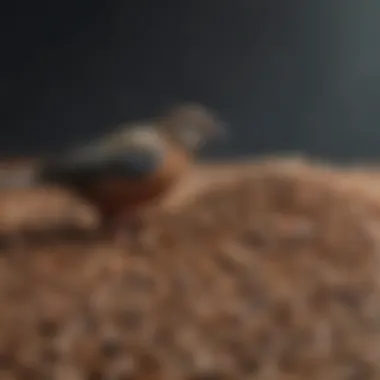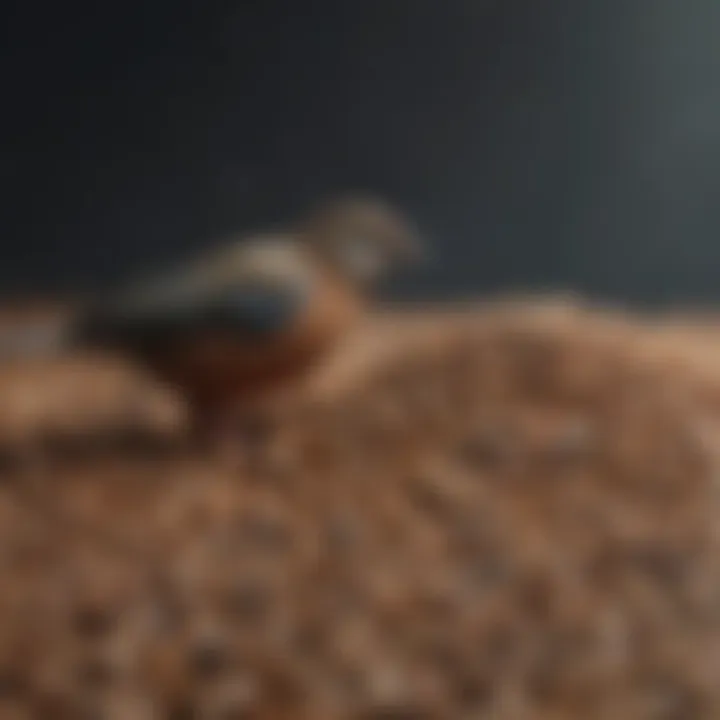Essential Strategies for Winter Bird Feeding


Intro
Feeding birds during the winter months is crucial for maintaining local avian populations. The cold weather can make it difficult for birds to find sufficient food sources. In this time of need, understanding bird behavior and their nutritional requirements becomes essential. This article aims to provide bird enthusiasts and gardening aficionados with strategies and best practices to support these animals effectively.
Key factors include the proper selection of food types, how to maintain feeding stations, and an awareness of migratory patterns that may affect local bird species. By following the guidance provided herein, individuals can greatly enhance the well-being of wintering birds, thus contributing positively to the local ecosystem.
Intro to Winter Bird Feeding
Feeding birds during the winter months is an important activity that offers various benefits to both birds and humans. Winter presents unique challenges for birds, as natural food sources become scarce. By providing food, one supports the local avian population and enhances the biodiversity of the ecosystem.
Moreover, winter bird feeding creates an opportunity for observation and engagement with nature. This practice encourages homeowners, gardening enthusiasts, and families to connect with their environment. Observing birds in their natural habitats can be a rewarding experience as it fosters appreciation for wildlife and promotes conservation efforts. Additionally, feeding birds improves their chances of survival when they face low temperatures and harsh weather conditions.
When engaging in winter bird feeding, there are specific elements to consider. Different bird species have varying dietary needs, which must be addressed by providing appropriate food types. Additionally, understanding the behavior of birds in winter can help to enhance feeding strategies and attract more species. A well-maintained feeding station is also crucial, as it ensures that food stays available and sanitary.
In summary, feeding birds in winter is not merely an act of kindness. It is a serious commitment to supporting local wildlife and contributing positively to the environment. By approaching winter bird feeding with informed strategies, one can create a thriving feeding station that benefits both the birds and the observer.
Importance of Feeding Birds in Winter
Feeding birds in winter plays a critical role in their survival. Many birds rely on human-provided food sources as natural habitats deteriorate in colder months. The availability of energy-rich foods can be essential for their endurance. In addition to survival, feeding can influence migratory behaviors, with some birds choosing to stay in areas with consistent food sources, altering their typical patterns.
"Providing food in winter helps sustain bird populations, enabling them to thrive in challenging conditions."
Thus, this practice gives birds a significant advantage during cold spells. Feeding birds can also be an educational experience for individuals and families, teaching about ecology, natural cycles, and responsible environmental stewardship.
Bird Types Commonly Encountered in Winter
Different bird species are commonly seen visiting feeders during winter due to their adaptation to colder climates. Some notable examples include:
- Northern Cardinals: Known for their bright red plumage, these birds are not only beautiful but also sociable, often visiting feeders in pairs.
- Blue Jays: Recognizable by their blue and white feathers, they are friendly and can adapt to various food sources.
- Black-capped Chickadees: With their distinctive black and white markings, they are curious and quick to approach feeders, often storing food for later.
- American Goldfinches: These birds are vibrant and may change their coloration slightly. They're often attracted to thistle seeds.
- Dark-eyed Juncos: Commonly seen on the ground beneath feeders, they thrive on seeds and are a regular winter presence.
Understanding the types of birds attracted to feeders can help in choosing the right food, enhancing the birdwatching experience, and encouraging diverse species to visit.
Understanding Bird Behavior in Cold Months
Understanding bird behavior during the cold months is crucial for anyone interested in feeding birds. The adaptability of these creatures can deeply affect their survival. Bird feeding not only provides essential nutrients but also offers a glimpse into their daily lives. Grasping how birds respond to winter conditions leads to more effective feeding practices. This knowledge is beneficial for both the birds and the enthusiasts who support them.
Adaptations to Cold Weather
Birds have developed several adaptations to survive the cold weather. These adaptations can be physical or behavioral. Physically, many birds grow denser feathers, which trap heat close to their bodies. This insulation prevents heat loss, helping them maintain their body temperature even in freezing conditions. Additionally, some species exhibit changes in metabolism. They may increase calorie intake to build fat reserves that fuel their energy needs during cold spells.
Behaviorally, birds adjust their activity patterns in response to temperature drops. They often move less during extremely cold spells to conserve energy. Many species also seek shelter during harsh weather, favoring dense trees, shrubs, or even man-made structures. Understanding these behavior patterns can inform feeding strategies, ensuring food stations are placed in safe, accessible locations.
Feeding Patterns and Habits
In winter, feeding patterns shift significantly due to the harsh conditions. Many birds will visit feeders more frequently now that natural food sources are scarce. This increased reliance on human-provided food is crucial for their survival.
Birds typically follow specific feeding habits, often resulting in predictable visits. For example, species like chickadees and nuthatches may arrive at feeders in the early morning to take advantage of the light. They often repeat this pattern daily. Individual preferences for food types also play a role. Some birds prefer seeds, while others may be drawn to suet or fruit offerings.
Observing these patterns allows enthusiasts to tailor their feeding practices more effectively. Noting which birds prefer specific foods can guide future selections. This attention enhances both bird engagement and overall winter feeding success.
Birds in winter often require more frequent feeding, as natural resources become limited. Providing consistent and appropriate feeds can significantly impact their well-being.
In summary, understanding bird behavior in cold months unveils critical elements for those interested in winter bird feeding. Not only do these insights enhance the feeding experience, but they also contribute to a healthier avian population.
Gardening aficionados and homeowners can thus take pride in their part in nurturing bird life during winter. By considering adaptations and feeding habits, one ensures that winter months are both supportive and enriching for these essential creatures.


Nutritional Needs of Winter Birds
Understanding the nutritional needs of winter birds is crucial for supporting their survival during the cold months. As temperatures drop, birds face challenges in finding adequate food sources. They require a diet high in energy to maintain body heat and support their metabolic needs. This need becomes especially urgent when natural food supplies are scarce, making bird feeders vital lifelines. Providing the right foods not only helps birds thrive but can also attract a variety of species to your garden, enhancing your winter birdwatching experience.
Types of Foods That Attract Birds
Various foods will attract different species of birds. The key is to offer a range of options to cater to the diverse diets of winter birds. Some birds prefer seeds, while others may be drawn to fruits or suet. Here are a few types of food that can entice birds during winter:
- Seeds: Many birds enjoy sunflower seeds, millet, and safflower.
- Suet: This high-fat option is favored by woodpeckers, nuthatches, and chickadees.
- Fruits: Dried fruits, such as raisins, or fresh apples and berries can be appealing.
- Nuts: Unsalted peanuts or tree nuts are also attractive to certain bird species.
High-Energy Foods for Harsh Conditions
High-energy foods are essential to provide sustenance when conditions are tough. They can make a significant difference in a bird's ability to survive the winter.
Seed Mixes
Seed mixes are popular among bird enthusiasts for their versatility. They often contain a blend of sunflower seeds, peanuts, and millet. This variety caters to multiple species, making seed mixes an effective choice for attracting a diverse bird population. One notable advantage of seed mixes is their high energy content, crucial for birds needing to maintain warmth. However, one downside is that they can attract unwanted pests, such as squirrels or larger birds.
Suet Blocks
Suet blocks are specifically designed to provide high-fat food sources for birds. Made from fat rendered from beef or other animals, they are rich in energy and readily accepted by many birds. Their density makes them an excellent choice in freezing temperatures when other food sources are diminished. They can also be enhanced with seeds or fruits to attract more species. A potential drawback is that suet can melt or spoil in warmer winter climates, limiting when it can be used.
Fruits and Nuts
Fruits and nuts offer diversity in the diet of winter birds. Items like raisins, apples, and various berries appeal not only to birds but also add an aesthetic value to feeders. Nuts provide healthy fats and protein, critical for winter survival. They can also attract species like jays and woodpeckers, which enjoy cracking open shells. The challenge with fruits and nuts is ensuring they remain fresh and do not spoil.
In summary, providing a variety of nutritional foods is essential for the health and survival of winter birds. By understanding their dietary preferences and offering a selection of seeds, suet, fruits, and nuts, one can create an inviting environment for these creatures.
"Feeding birds in winter not only supports wildlife but also enriches the local ecosystem in profound ways."
For more comprehensive information, refer to resources like Britannica or Wikipedia.
Setting Up Bird Feeders
Setting up bird feeders is a crucial step in supporting bird populations during the harsh winter months. Proper installation and maintenance of feeders not only attract birds but also provide them with necessary nourishment. This section discusses various types of feeders and their optimal placements, making it essential for anyone interested in promoting wildlife in their backyard.
Types of Feeders Available
Different feeders serve different purposes and attract various types of birds. Understanding these types can optimize your efforts.
Tube Feeders
Tube feeders are cylindrical and designed to hold seeds. They typically have small holes at the base, allowing birds to access food while preventing larger animals from stealing it. A key characteristic of tube feeders is their capacity to accommodate multiple feeding birds at once. This makes them a favorable choice for attracting many small songbirds, such as chickadees and finches.
The unique feature of tube feeders is their weather resistance. Most are made with durable materials that protect seed from rain and snow. This advantage means less frequent refills, as seeds stay dry for longer. However, some disadvantages exist. Tube feeders can necessitate regular cleaning to avoid molded seeds, and their design may limit access for larger birds like cardinals.
Platform Feeders
Platform feeders have a flat, open surface that allows birds to perch and access food easily. Their simplicity is a vital characteristic, as it offers a buffet-style experience for various bird species. These feeders can attract not only smaller birds but also larger ones, such as doves and jays. Thus, they are beneficial for creating a diverse bird environment.
One unique aspect is the versatility of platform feeders. They can be placed on the ground, hung from trees, or mounted on poles. This adaptability can become a disadvantage, though, since they expose seeds to environmental elements, leading to quicker spoilage. Regular monitoring of food supply is crucial to maintain hygiene and food quality.
Hopper Feeders
Hopper feeders store a significant amount of seeds, allowing birds to feed from the lower section. Their design resembles a small house or barn, making them attractive garden features. A key characteristic of hopper feeders is their ability to keep seeds dry, as they usually feature a roof that protects the seeds from rain and snow. This is particularly beneficial in winter conditions, reducing refill frequency.
The unique feature is their large capacity, which can be advantageous for bird watchers who prefer less frequent refills. However, they also come with downsides. Hopper feeders can be more challenging to clean, as the design may trap old seeds or debris. It's important to check them regularly to ensure that food remains fresh for the birds.


Optimal Locations for Feeders
Choosing the right location for bird feeders plays a significant role in attracting birds. A good spot ensures safety from predators and offers convenience for feeding. Consider placing feeders near natural cover, like shrubs or trees, which provide shelter for birds. Sunny locations are usually preferable for winter, as they help keep the food warm.
Another essential consideration is visibility. Placing feeders where they can be easily seen from a window can improve your bird-watching experience. Additionally, ensure the area is free from disturbances. Frequent human traffic can deter birds from visiting the feeders. With the right setup, feeding birds in winter becomes more rewarding and effective.
"A well-placed bird feeder not only supports wildlife but enriches personal observation and connection with nature."
In summary, selecting appropriate feeders and optimal locations can significantly enhance winter bird feeding efforts. All mentioned points about feeders help to establish a feeding routine that benefits both the birds and their observers.
Maintaining Feeding Stations
Maintaining feeding stations during the winter months is crucial for keeping birds healthy and well-fed. Proper maintenance ensures that your feeding efforts are effective and beneficial for the birds that visit your yard. A well-maintained feeding station can attract a variety of bird species to your area, enhancing your birdwatching experience and supporting local ecosystems.
Cleaning and Hygiene Practices
Regular cleaning of bird feeders cannot be overstated. The accumulation of old food, waste, and mold can pose health risks to birds. To maintain hygiene, follow these simple steps:
- Clean feeders regularly, ideally every two weeks.
- Use hot water and a mild detergent to wipe down feeders.
- Rinse thoroughly to remove any soap residue.
- Consider using a 10% bleach solution for tougher mold stains, but ensure feeders are rinsed completely afterward.
Always empty the feeders before cleaning. How the feeders are placed also matters. Avoid placing feeders too close to the ground to reduce the chances of contamination from droppings. Furthermore, avoid overcrowding feeders. Space them out to allow for proper air circulation, deterring mold buildup.
Assessing Food Supplies
Keeping a close eye on food supplies is vital for effective bird feeding. Assessing these supplies helps you know when to refill and what to avoid wasting. Here are some considerations when monitoring your food stocks:
- Check feeder levels regularly to ensure they are filled.
- Store birdseed in a cool, dry place to prolong its freshness.
- Opt for high-quality seeds like black oil sunflower seeds, as they attract a variety of birds.
- Keep track of which types of foods are consumed quickly and which are left behind, adjusting your offerings accordingly.
Understanding the dietary habits of local birds can guide your decisions on what to provide in your feeders. Some birds prefer seed mixes, while others might be attracted to suet blocks or fruits. By using a combination of these food types, you can cater to different species throughout the winter.
"A well-maintained feeding station can greatly enhance your winter birdwatching experience and support your local avian ecosystem."
Ensuring your feeding stations are maintained properly is an investment in both the environment and your enjoyment of winter bird feeding.
Dealing with Challenges
Feeding birds in winter presents unique obstacles. Understanding these challenges is essential for providing an effective feeding environment. Homeowners must consider both natural predators and environmental conditions that can disrupt feeding efforts. Addressing these issues not only improves the survival of winter birds but also enhances the bird-watching experience.
Predators and Pests
Bird feeders attract various species, some welcome and others less so. Common predators include feral cats, hawks, and even squirrels. These animals find feeders a reliable food source, which can reduce the number of birds visiting your setup.
- Feral Cats: They pose a significant threat. Birds are vulnerable when feeding. Protect feeders by elevating them off the ground. Using squirrel-proof feeders can also help as they are designed to keep larger animals at bay.
- Hawks: These birds of prey often perch nearby, waiting for smaller birds to emerge. Consider placing feeders near dense shrubbery. This gives smaller birds cover when they feed.
- Squirrels: While not predators, they consume bird food and can damage feeders. Using baffles or squirrel-proof designs can mitigate this challenge.
In addition to natural predators, various pests can disrupt bird feeding. Ants often invade feeders, particularly in warmer winter regions.
- Ant Prevention: Applying petroleum jelly on feeder poles can deter ants. Regularly check feeders to remove any pests potentially spoiling the food supply.
Weather-Related Challenges
Weather significantly affects bird feeding habits. Cold temperatures often lead to increased competition for food sources. Snow and ice can cover natural food supplies, making artificial feeders vital. However, harsh conditions can also complicate feeding.
- Snow and Ice: Heavy snowfall can bury feeders, rendering them inaccessible. Ensuring feeders are elevated, and regularly clearing away snow will help maintain accessibility.
- Wind and Storms: Strong winds can sway feeders and spill food. Choose sturdy feeders that can withstand variable weather. Location matters too; placing feeders in sheltered spots reduces wind interference.
- Temperature Fluctuations: Sudden temperature drops can cause food in feeders to freeze. High-energy foods, such as oil seeds or suet, are most beneficial during these times. They remain accessible even in lower temperatures.
Addressing these challenges requires foresight and willingness to adapt. Regularly monitoring feeders and observing local wildlife can inform best practices.
Remember: Maintaining a bird-feeding station is not only about filling feeders. It's about creating a safe haven for birds during the chilly months.


The Environmental Impact of Feeding Birds
Feeding birds in winter has significant implications for the local environment. It can create a network of support for birds during the cold months, ensuring their survival and promoting biodiversity. By understanding these impacts, homeowners can contribute to a healthier ecosystem. The act of feeding birds plays a pivotal role in aiding the survival of various species, especially during harsh winter conditions when natural food sources are limited.
Bird feeding isn't just about providing a snack; it is about fostering an environment where birds thrive. When done responsibly, it supports local food chains and enhances bird populations in the area. This can lead to more diverse wildlife interactions, thereby enriching the ecological tapestry of gardens and parks.
"The act of feeding birds influences their behavior and movement patterns, integrating human activity with local wildlife."
Supporting Local Ecosystem
Feeding birds can support the local ecosystem in various ways. First, it can attract species that play important roles in pollination and seed dispersal. When you place feeders in your yard, you may find species like goldfinches or chickadees, which contribute to the dispersal of seeds from the fruits they eat. This helps plants to grow and increase the number of native species.
Moreover, by facilitating bird populations, you're also enhancing the food web. Birds often serve as prey for larger wildlife, such as hawks and owls. By maintaining a balanced population of these small creatures, you are helping sustain the larger bird populations that depend on them. This interconnectedness is vital for ecological resilience, especially in urban areas where habitats are fragmented.
Responsible Practices for Bird Feeding
To ensure that your bird feeding practices are beneficial to the ecosystem, consider the following responsible practices:
- Select appropriate food types: Choose high-quality seeds such as sunflower seeds or nyjer seed that are preferable to local birds.
- Avoid feeding bread: Bread can be harmful to birds. It contains little nutritional value and can lead to health issues.
- Regularly clean feeders: Clean feeders to prevent the spread of disease. Fungal infections can easily spread in dirty feeders.
- Monitor bird species: Keep track of the types of birds visiting your feeder and adjust your methods to ensure you're meeting their needs.
- Be mindful of seasonality: By varying food offerings based on seasonal requirements, you can encourage healthy feeding habits.
By adhering to these practices, you maximize the positive environmental impact of your feeding efforts and promote a more sustainable approach to supporting winter birds.
Engaging with Bird Watching
Bird watching during the winter is a fulfilling activity that connects individuals with nature. Observing birds can bring joy, tranquility, and education. When you engage with bird watching, you develop a better understanding of the species around you. This connection fosters a sense of responsibility toward their well-being, especially in challenging winter months. Through the act of watching, you can identify feeding habits, social behaviors, and various species that visit your yard.
One specific benefit of bird watching is the mental health aspect. Studies show that spending time outdoors has positive effects on mood and stress reduction. Connecting with nature through bird watching allows for moments of reflection. You may find this especially valuable during the colder months, when outdoor activities can be limited.
Tracking Bird Species
Tracking bird species involves observing and documenting different types of birds that come to your feeders. It can be done through simple note-taking or using birding apps. Start by listing the common birds you see, such as chickadees, cardinals, and finches. With time, you may notice seasonal variability or shifts due to weather changes.
This activity can deepen your understanding of avian behavior. By noting when specific species appear or disappear, you can make connections to food availability and environmental conditions. Using field guides or online resources from sites like en.wikipedia.org can enhance your identification skills.
Engaging in this way not only enriches your experience but also contributes to the knowledge base about local bird populations.
Participating in Citizen Science Projects
Many organizations welcome participants to contribute to citizen science projects regarding bird populations. These initiatives often involve monitoring local species and reporting findings. Engaging in activities like the Great Backyard Bird Count, you can collect valuable data that helps scientists track species distribution and behavior.
Such participation arms you with the power to contribute meaningful insights to ecological studies. It might seem small, but individual observations gathered across a broad community can result in substantial data collections. This lays the groundwork for understanding shifts in ecosystems and can even have implications for conservation efforts.
"Every small observation matters. Collective data from engaged citizens can guide important conservation strategies."
Additionally, these projects often foster a sense of community. Joining local bird watching groups, or online forums like reddit.com, allows you to share experiences and learn from others. The relationships and knowledge gained from these connections can enhance your bird feeding practices while encouraging responsible bird watching habits.
Closure
Concluding an exploration on the feeding of birds during winter is essential in understanding the broader implications of our actions on these creatures and the environment. The article has highlighted why it is crucial to adjust our practices to meet the unique challenges faced by birds in the colder months. By regularly feeding, we not only help improve their survival odds but also enrich our own experience as observers of nature.
Summary of Key Points
Throughout the article, several key elements have emerged:
- Importance of Winter Feeding: Providing food during winter significantly aids birds who struggle with scarce resources.
- Behavioral Understanding: Birds have distinct habits in colder months that dictate how and when they feed.
- Nutritional Needs: Different bird species require specific diets that cater to their energy needs, especially in harsh conditions.
- Feeder Maintenance: Regular upkeep of feeding stations ensures safe, reliable access to food for visiting birds.
- Environmental Impact: Our feeding practices can promote biodiversity and support local ecosystems if managed properly.
Future Considerations in Bird Feeding
As we move forward, it is imperative to consider the evolving needs of winter birds. Here are some future points to keep in mind:
- Diversification of Food Sources: Experimenting with various foods can attract diverse bird species to your feeder. Understanding specific dietary preferences is key.
- Adjusting Feeder Locations: Observing bird activity will provide insights into the optimal positioning of feeders to maximize visits.
- Climate Awareness: Climate change may affect migratory patterns. Stay informed on how this affects local bird populations.
- Community Engagement: Join local groups or online platforms, such as Reddit or Facebook, to share experiences and learn from other bird enthusiasts.
By maintaining a focus on these aspects, we can ensure effective bird feeding strategies that are beneficial not just for the birds but for our communities as well. Embracing these practices promises a more intricate understanding of our avian neighbors as we support their needs throughout the winter months.



